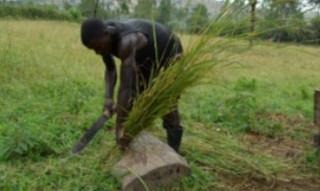Uganda stakeholder workshop
Juliet Sentumbwe, director of animal resources at MAAIF, commended ILRI’s pig value chain work in Uganda over the past 10 years. She said the research ‘has been instrumental in raising the profile of the pig sector and pig farming is now recognized as a major livelihood activity, especially for women and youth in Uganda.’ She praised SAPLING’s timely focus on developing the country’s beef value chain, noting that ‘beef is highlighted in the National Development Plan (NDPIII) 2020/21 – 2024/25 as one of the 10 commodities to foster the sustainable agro-industrialization of Uganda.’
Pig value chains
Pig production is an important economic activity in Uganda. According to the government, in 2017, there were 4.2 million pigs the country, which also has the highest per capita consumption of pork in East Africa, estimated at 3.4 kilograms per person per year (Food and Agriculture Organization of the United Nations FAO,2018 ). Pig production, which is intensifying as farmers embrace exotic breeds such as Landrace, Large White, and crossbreeds such Camborough, provides an income for more than two million Ugandan households. Pigs are mostly raised by smallholder farmers, three-quarters of whom are women.
But the sector is highly informal and faces challenges such as inefficient input and output markets, poor governance (lack of collectives), low productivity and gender norms that are unfavourable to the participation of women and youths. These factors contribute to the vulnerability and unsustainability of the pig production system in Uganda.
Participants at the workshop envisioned a vibrant, inclusive, profitable and resilient pig value chain in Uganda by 2032, resulting in improved livelihoods for pork producers and other value chain actors and enhanced food and nutritional security. In the long-term, stakeholders and partners anticipate improved pig value chain efficiency, improved pig productivity and increased consumption of livestock-derived foods as part of nutrition diverse diets. Implementation of various innovation packages under SAPLING is also expected to result in increased investment in infrastructure by the private sector, processing and value addition, and increased gainful participation of women and youths in the pig industry.

Emily Ouma, a senior scientist at the ILRI Uganda office, facilitates the visioning and problem statement process with pig value chain stakeholders at the workshop (photo credit: ILRI/Pamela Wairagala).
Beef and dairy cattle value chains
Uganda has more than 11.4 million cattle (93.6% are indigenous/native breeds, 0.8% are beef [exotic or crossbred] and 5.6% dairy [exotic or crossbred]) but their productivity is low due to livestock diseases, poor breeds and breeding, scarcity of pasture and low quantity and quality of water. Climate change and poor extension service delivery further exacerbate these challenges and often result in high animal mortality and reduced household incomes. . Poor coordination amongst value chain actors, limited access to knowledge, information, and non-compliance with laws and regulations are bottlenecks in the dairy value chain, which coupled with poor milk handling, cause inefficiencies in value addition and market access.

A Udandan farmer prepares forage feed for cattle (photo credit: ILRI/Pamela Wairagala)
SAPLING interventions
Over the next 10 years, SAPLING interventions will empower actors in the beef value chain to increase the sustainable productivity, production and consumption of beef products, improve participation and inclusion of youths and women along the value chain, and promote consumption of healthy animal-source foods.
For the dairy value chain, stakeholders envision a resilient, inclusive, profitable, competitive and sustainable sector. A 30% increase in milk production, productivity and quality as well as adoption of sustainable climate-smart and locally developed technologies and innovations by farmers is projected. Improved access to milk and milk product markets, safe transportation of milk, value addition, promotion of local milk consumption and stimulated demand for processed milk are also expected to promote sector growth and improve household incomes.
Click here to see more...